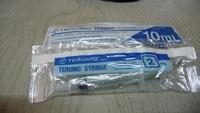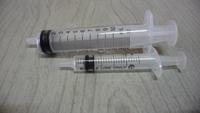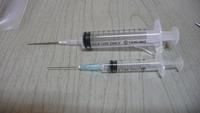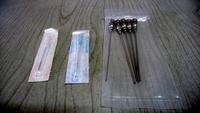
South Australian Medical Heritage Society Inc
Website for the Virtual Museum
Home
Coming meetings
Past meetings
About the Society
Main Galleries
Medicine
Surgery
Anaesthesia
X-rays
Hospitals,other organisations
Individuals of note
Small Galleries
Ethnic medicine
- Aboriginal
- Chinese
- Mediterran
Disposable Syringes
This article is mostly about disposable syringes. For more on syringes in general, you may wish to read our previous article "A History of Syringes".
The word syringe comes from the Greek "σύριγξ" ("syrinx"), meaning a tube, pipe or a reed. It is also another name for a Pan pipe, named after the nymph Syrinx who was turned into a river reed while trying to escape the advances of Pan, from which he then cut and made his famous pipe.
It is uncertain when the first syringes were created, but there are records of their use dating from the 1st century CE. In his book "De Medicina", Aulus Cornelius Celsus (c. 25 - c. 50 CE) wrote about cleaning wounds using a syringe filled with wine or vinegar, or using one to remove pus. Hero of Alexandria ( c. 10 - c. 70 CE) described the construction of a syringe, calling it a "pyoulcus" (or "pyulkos"), "pus puller", in his "Pneumatics". This type of device was used by Ctesibius around 280 BCE, but there are records dating even earlier (eg: Aristotle, 384-322 BCE, in "Of the Falling of the Womb").
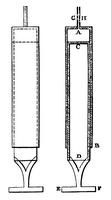
From "Pneumatics", translated by Bennet Woodcroft, pg 80.
Prior to the early 20th century, syringes were usually made out of either metal or glass. These were far to expensive to dispose of after only one use, and this limited their availability. A cheap syringe would be beneficial as it could be thrown out after use, reducing the probability of cross-contamination, reduce transmission of diseases, and remove the need for repeated cleaning and sterilization.
One of the first disposable syringes was developed by James T Greenley, with the patent granted in 1912. It consisted of a flexible tube (much like a superglue or toothpaste tube) containing a certain amount of fluid, and a hypodermic needle. These could be filled with a pain killer such as morphine, and were very useful in WW1 for medics and soldiers alike.
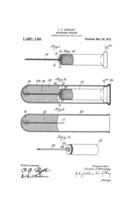
The Becton Dickinson company is credited with creating the first mass disposable syringe in 1954. Made from glass, the Hypak syringe was used in the administration of the Salk polio vaccine. They later developed their plastic "Plastipak" syringe in 1961.
One of the earliest disposable plastic syringes was designed by Charles Rothauser. He was born in Budapest in 1913, and later migrated to Adelaide, South Australia. He founded the "Quality Toy Company" in 1939, making dolls. This company would later be renamed Caroma, and is now famous for its bathroom fixtures. Around 1949, penicillin injections became common, but they clogged the glass syringes. Rothauser developed a disposable polyethylene plastic needle, which had the advantages of being cheap, and not needing to be cleaned. It did have the disadvantage that it could not be sterilized by heat, and had to be sterilized by more expensive chemical treatments instead. In 1951, he redesigned the syringe to be made out of polypropylene, which could safely be sterilized by heating. As an aside, Rothauser also invented the first one piece injection moulded plastic toilet cistern.
Other claims of being the first mass producers of plastic syringes include the Roehr "Monoject" in 1955, and Colin Murdoch, who made a plastic version based on the existing glass ones in 1956.
Syringes and needles vary in size. The syringes above have volumes of 2 and 10cc. Their needles also differ. The one with the light pink coloured "neck" is an 18 gauge needle (1.270mm outer diameter), and the blue one is a little thinner at 28 gauge (0.3620mm). One common standards system used by needles (and other tubes) is the Birmingham gauge, and the connector is colour coded to indicate the gauge.
